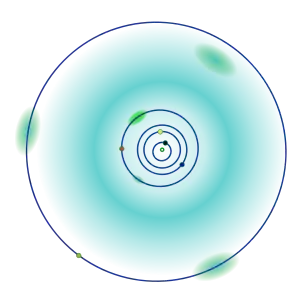Mars trojan
The Mars trojans are a group of Trojan objects that share the orbit of the planet Mars around the Sun. They can be found around the two Lagrangian points 60° ahead of and behind Mars. The origin of the Mars trojans is not well understood. One theory suggests that they were primordial objects left over from the formation of Mars that were captured in its Lagrangian points as the Solar System was forming. However, spectral studies of the Mars trojans indicate this may not be the case.[1][2] Another explanation involves asteroids chaotically wandering into the Mars Lagrangian points later in the Solar System's formation. This is also questionable considering the short dynamical lifetimes of these objects.[3][4] The spectra of Eureka and two other Mars trojans indicates an olivine-rich composition.[5] Since olivine-rich objects are rare in the asteroid belt it has been suggested that some of the Mars trojans are captured debris from a large orbit-altering impact on Mars when it encountered a planetary embryo.[6][3]


Sun · 1999 UJ7 · Mars

Sun · 2007 NS2 · Mars
Presently, this group contains 14 asteroids confirmed to be stable Mars trojans by long-term numerical simulations but only nine of them are accepted by the Minor Planet Center (†).[7][3][4][8][9][10][11]
Due to close orbital similarities, most of the smaller members of the L5 group are hypothesized to be fragments of Eureka that were detached after it was spun up by the YORP effect (Eureka's rotational period is 2.69 h). The L4 trojan 1999 UJ7 has a much longer rotational period of ~50 h, apparently due to a chaotic rotation that prevents YORP spinup.[12]
L4 (leading):
L5 (trailing):
See also
- Trojan (celestial body)
- Minor planets that orbit near trojan points
References
- Rivkin, Andrew; Trilling, David; Thomas, Cristina; DeMeo, Fancesca; Spahr, Timoth; Binzel, Richard (2007). "Composition of the L5 Mars Trojans: Neighbors, not siblings". Icarus. 192 (2): 434–441. arXiv:0709.1925. Bibcode:2007Icar..192..434R. doi:10.1016/j.icarus.2007.06.026.
- Trilling, David; Rivking, Andrew; Stansberry, John; Spahr, Timothy; Crudo, Richard; Davies, John (2007). "Albedos and diameters of three Mars Trojan asteroids". Icarus. 192 (2): 442–447. arXiv:0709.1921. Bibcode:2007Icar..192..442T. doi:10.1016/j.icarus.2007.08.002.
- Scholl, H.; Marzari, F.; Tricarico, P. (2005). "Dynamics of Mars Trojans". Icarus. 175 (2): 397–408. Bibcode:2005Icar..175..397S. doi:10.1016/j.icarus.2005.01.018.
- Schwarz, R.; Dvorak, R. (2012). "Trojan capture by terrestrial planets". Celestial Mechanics and Dynamical Astronomy. 113 (1): 23–34. arXiv:1611.07413. Bibcode:2012CeMDA.113...23S. doi:10.1007/s10569-012-9404-4.
- Borisov, G.; Christou, A.; Bagnulo, S.; Cellino, A.; Kwiatkowski, T.; Dell'Oro, A. (2017). "he olivine-dominated composition of the Eureka family of Mars Trojan asteroids". Monthly Notices of the Royal Astronomical Society. 466 (1): 489–495. arXiv:1701.07725. Bibcode:2017MNRAS.466..489B. doi:10.1093/mnras/stw3075.
- Polishook, D.; Jacobson, S. A.; Morbidelli, A.; Aharonson, O. (2017). "A Martian origin for the Mars Trojan asteroids". Nature Astronomy. 1: 0179. arXiv:1710.00024. Bibcode:2017NatAs...1E.179P. doi:10.1038/s41550-017-0179.
- "List Of Martian Trojans". Minor Planet Center. Retrieved 2021-01-12.
- de la Fuente Marcos, Carlos; de la Fuente Marcos, Raúl (April 2013). "Three new stable L5 Mars Trojans". Monthly Notices of the Royal Astronomical Society: Letters. 432 (1): L31–L35. arXiv:1303.0124. Bibcode:2013MNRAS.432L..31D. doi:10.1093/mnrasl/slt028.
- Christou, A. A. (2013). "Orbital clustering of Martian Trojans: An asteroid family in the inner solar system?". Icarus. 224 (1): 144–153. arXiv:1303.0420. Bibcode:2013Icar..224..144C. doi:10.1016/j.icarus.2013.02.013.
- Christou, Apostolos A.; Borisov, Galin; Dell'Oro, Aldo; Cellino, Alberto; Devogèle, Maxime (January 2021). "Composition and origin of L5 Trojan asteroids of Mars: Insights from spectroscopy". Icarus. 354 (1): 113994 (22 pages). arXiv:2010.10947. Bibcode:2021Icar..35413994C. doi:10.1016/j.icarus.2020.113994.
- de la Fuente Marcos, Carlos; de la Fuente Marcos, Raúl (March 2021). "Using Mars co-orbitals to estimate the importance of rotation-induced YORP break-up events in Earth co-orbital space". Monthly Notices of the Royal Astronomical Society. 501 (4): 6007–6025. arXiv:2101.02563. Bibcode:2021MNRAS.501.6007D. doi:10.1093/mnras/stab062.
- Lovett, R. (2017-10-20). "Sun's light touch explains asteroids flying in formation behind Mars". Science. doi:10.1126/science.aar2794.